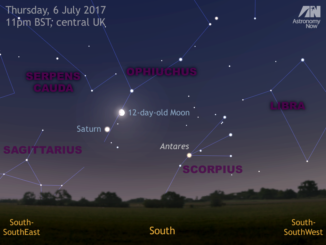As summer approaches in the northern hemisphere of Titan, Saturn’s largest moon, NASA’s Cassini spacecraft has succeeded in measuring the depth of its largest liquid methane/ethane sea, the 400,000 square kilometre Kraken Mare, and re-examined the transient feature in Ligeia Mare dubbed the ‘Magic Island’. These findings and more are presented this week at the Division for Planetary Sciences Meeting of the American Astronomical Society in Tucson, Arizona, by Cornell University planetary scientist Alexander Hayes.

Using the same techniques developed to measure the depths of Ligeia Mare in May 2013, the Cassini Radar Team imaged a 200 km-long swathe shore-to-shore across Kraken Mare on August 21st, 2014 and managed to isolate reflections from a shallow 40 km segment of the seafloor. The distinctive double-peaked returns from a region near the mouth of a flooded river valley that feeds the sea indicates liquid methane depths of 20-35 m. No observations of Kraken Mare’s seafloor were made during the remaining 160 km-long track, indicating that the liquid was either too deep (> 200 m [650 m]) or much more absorbing than that found in Ligeia Mare. However, altimetry data shows steeply sloped dry land leading up to Kraken Mare that is consistent with (but not proof of) deep liquid.
Cassini scientists are still analysing the data to determine the liquid methane’s composition and absorptivity, but unlike the 160 m depth of central Ligeia Mare, the shallow depths recorded for Kraken Mare make this calculation difficult. However, using these new techniques to examine 2008 altimetry data for Ontario Lacus, Titan’s largest south polar lake, has indicated depths of 20-40 m for the lake’s southern regions for the first time.
The Cassini team also turned their attention to Titan’s mysteriously variable ‘Magic Island‘, covering an area of some 260 square kilometres in the Ligeia Mare, first seen in July 2013. Images created from Synthetic Aperture Radar (SAR) data returned during the August 2014 flyby showed that bright features were again present at the former location, but their appearance has evolved. Waves, bubbles or floating debris provide the best explanation for these features at the present time.

A further exciting development from the August 2014 Titan flyby provides evidence that Kraken Mare has at least two ‘Magic Islands’ of its own. The Kraken transients were captured by Cassini’s Visible and Infrared Mapping Spectrometer (VIMS) within several hours of observations. The VIMS data show a 5-micron-bright detection at the same location as the radar transients, interpreted as being similar to specular reflections from waves, wet ground or wet floating debris.
Cassini’s radar and VIMS data reveals the dynamic nature of Titan’s polar seas, exciting environments poised to yield further secrets when the spacecraft is scheduled to observe the Ligeia features again in January 2015.
The Cassini-Huygens mission is a cooperative project of NASA, the European Space Agency and ASI, the Italian Space Agency. JPL, a division of the California Institute of Technology in Pasadena, manages the mission for NASA’s Science Mission Directorate, Washington. The VIMS team is based at the University of Arizona in Tucson. The radar instrument was built by JPL and the Italian Space Agency, working with team members from the US and several European countries.
More information about Cassini and its mission:
http://www.nasa.gov/cassini
http://saturn.jpl.nasa.gov



